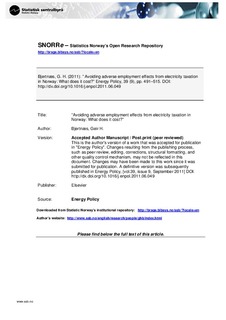| dc.contributor.author | Bjertnæs, Geir Haakon | |
| dc.date.accessioned | 2012-02-10T10:34:13Z | |
| dc.date.available | 2012-02-10T10:34:13Z | |
| dc.date.issued | 2011 | |
| dc.identifier.citation | Energy Policy, volume 39, issue 9, September 2011, pp. 4766-4773 | no_NO |
| dc.identifier.issn | 1873-6777 | |
| dc.identifier.other | DOI: http://dx.doi.org/10.1016/j.enpol.2011.06.049 | |
| dc.identifier.uri | http://hdl.handle.net/11250/178152 | |
| dc.description | Accepted Author Manuscripts (post-print) : This is the author's version of a work that was accepted for publication in "Energy Policy". Changes resulting from the publishing process, such as peer review, editing, corrections, structural formatting, and other quality control mechanism, may not be reflected in this document. Changes may have been made to this work since it was submitted for publication. A definitive version was subsequently published in Energy Policy, [vol.39, issue 9, September 2011] DOI: http://dx.doi.org/10.1016/j.enpol.2011.06.049 | no_NO |
| dc.description.abstract | Welfare analyses of energy taxes typically show that systems with uniform rates perform better than
differentiated systems. However, most western countries include some exemptions for their energyintensive
export industries and thereby avoid this potential welfare gain. B¨ohringer and Rutherford
(1997) find that uniform taxation of carbon emissions in combination with a wage subsidy preserves
jobs in these industries at a lower welfare cost compared with a differentiated system. The wage
subsidy scheme generates a substantial welfare gain per job saved. This study, however, finds that
welfare costs are substantial when less accurate policy measures, represented by productiondependent
subsidies, protect jobs in Norwegian electricity-intensive industries. The welfare cost per
job preserved by this subsidy scheme amounts to approximately 60% of the wage cost per job,
suggesting that these jobs are expensive to preserve. A uniform electricity tax combined with
production-dependent subsidies preserves jobs at a lower welfare cost compared with the current
differentiated electricity tax system. | no_NO |
| dc.language.iso | eng | no_NO |
| dc.publisher | Elsevier | no_NO |
| dc.subject | Energy taxes | no_NO |
| dc.subject | Electricity taxation | no_NO |
| dc.subject | Energiavgifter | no_NO |
| dc.subject | Computable general equilibrium model (CGE model) | no_NO |
| dc.subject | Energipolitikk | no_NO |
| dc.subject | Carbon emissions | no_NO |
| dc.subject | Welfare costs | no_NO |
| dc.subject | Employment | no_NO |
| dc.subject | Norway | no_NO |
| dc.subject | Political feasibility | no_NO |
| dc.subject | Arbeidsmarked | no_NO |
| dc.subject | Scientific article | |
| dc.title | Avoiding adverse employment effects from electricity taxation in Norway: What does it cost? | no_NO |
| dc.type | Journal article | no_NO |
| dc.type | Peer reviewed | no_NO |
| dc.subject.nsi | VDP::Social science: 200::Economics: 210::Economics: 212 | no_NO |
| dc.source.pagenumber | 4766-4773 | no_NO |
| dc.source.volume | 39 | no_NO |
| dc.source.journal | Energy Policy | no_NO |
| dc.source.issue | 9 | no_NO |
